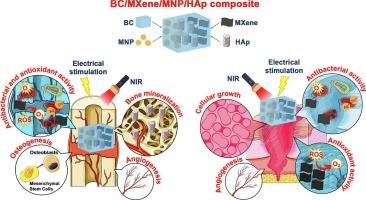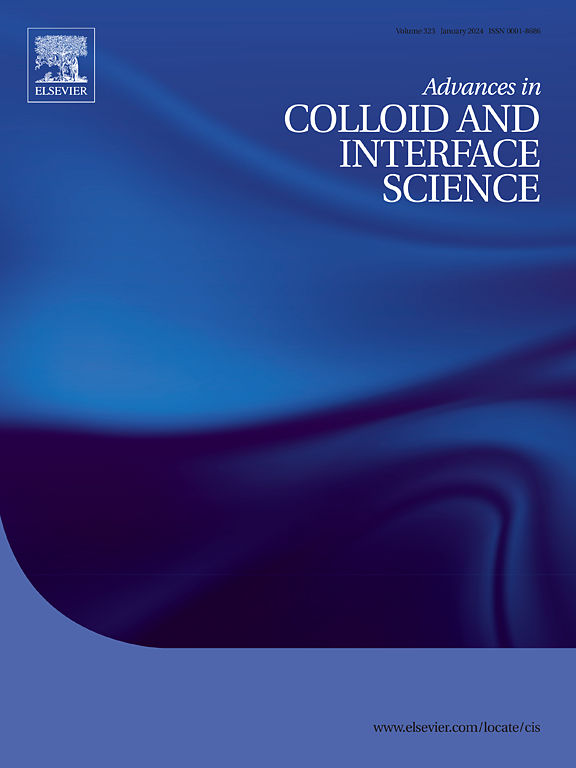组织工程中的先进生物材料:基于细菌纤维素、MXenes、羟基磷灰石和金属颗粒的再生医学纳米复合材料的综述
IF 19.3
1区 化学
Q1 CHEMISTRY, PHYSICAL
引用次数: 0
摘要
软硬组织的再生潜力有限,这促使人们寻找能够更好地模仿其复杂动态的先进生物材料。单独而言,细菌纤维素(BC)具有良好的生物相容性,但缺乏促进组织再生所需的固有生物活性和功能特性。羟基磷灰石(HAp)具有骨导电性,但表现出脆性。金属纳米颗粒(MNPs)具有抗氧化、抗菌和药物传递特性,但可能有毒。最后,MXenes具有良好的导电性,但缺乏对其长期生物相容性的了解。为了解决这些材料限制,研究人员探索了BC合成的遗传修饰和MXenes和MNPs的表面修饰等方法。本文综述了基于BC、MXene、HAp和MNPs的单体和杂化材料的合成方法、结构特性和生物医学应用。对现有复合材料的分析建立了对其相容性的强烈认识,这支持了将其成功集成到多功能BC/MXene/MNP/HAp四组分复合材料中的可能性。它有望表现出骨诱导、导电性、抗菌活性和结构支持的组合,以改善组织修复。然而,挑战包括MNPs的潜在细胞毒性以及关于MXenes对特定标记物以外的基因表达的更广泛影响的有限研究。这篇综述揭示了一种新的复合材料的发展,通过总结当前的知识和突出关键差距,可以解决当前生物材料功能的局限性。旨在为合理设计用于先进再生治疗的BC/MXene/MNP/HAp复合材料奠定基础和启发未来的研究。本文章由计算机程序翻译,如有差异,请以英文原文为准。

Advanced biomaterials in tissue engineering: A critical review of nanocomposites based on bacterial cellulose, MXenes, hydroxyapatite, and metal particles for regenerative medicine
Soft and hard tissues have limited regenerative potential that fuels the search for advanced biomaterials able to mimic their complex dynamics better. Individually, bacterial cellulose (BC) provides excellent biocompatibility but lacks inherent bioactivity and functional properties needed to promote tissue regeneration. Hydroxyapatite (HAp) offers osteoconductivity but shows brittleness. Metal nanoparticles (MNPs) have antioxidant, antimicrobial, and drug-delivery properties, but may be toxic. Lastly, MXenes possess good conductivity but lack knowledge of their long-term biocompatibility. To address these material limitations, approaches like genetic modifications to BC synthesis and surface modifications of MXenes and MNPs are explored. This review examines synthesis methods, structural properties, and biomedical applications of individual and hybrid materials based on BC, MXene, HAp, and MNPs. Analysis of existing composite materials establishes a strong recognition of their compatibility, which supports the possibility of their successful integration into a multifunctional BC/MXene/MNP/HAp four-component composite. It is expected to exhibit a combination of osteoinduction, electrical conductivity, antibacterial activity, and structural support to improve tissue repair. However, challenges include the potential cytotoxicity of MNPs and limited studies on the broader impact of MXenes on gene expression beyond specific markers. This review sheds light on the development of a new composite material that can address current limitations in biomaterial functionality by summarizing current knowledge and highlighting critical gaps. It aims to establish a foundation and inspire future studies towards rationally designing BC/MXene/MNP/HAp composites for advanced regenerative therapies.
求助全文
通过发布文献求助,成功后即可免费获取论文全文。
去求助
来源期刊
CiteScore
28.50
自引率
2.60%
发文量
175
审稿时长
31 days
期刊介绍:
"Advances in Colloid and Interface Science" is an international journal that focuses on experimental and theoretical developments in interfacial and colloidal phenomena. The journal covers a wide range of disciplines including biology, chemistry, physics, and technology.
The journal accepts review articles on any topic within the scope of colloid and interface science. These articles should provide an in-depth analysis of the subject matter, offering a critical review of the current state of the field. The author's informed opinion on the topic should also be included. The manuscript should compare and contrast ideas found in the reviewed literature and address the limitations of these ideas.
Typically, the articles published in this journal are written by recognized experts in the field.

 求助内容:
求助内容: 应助结果提醒方式:
应助结果提醒方式:


